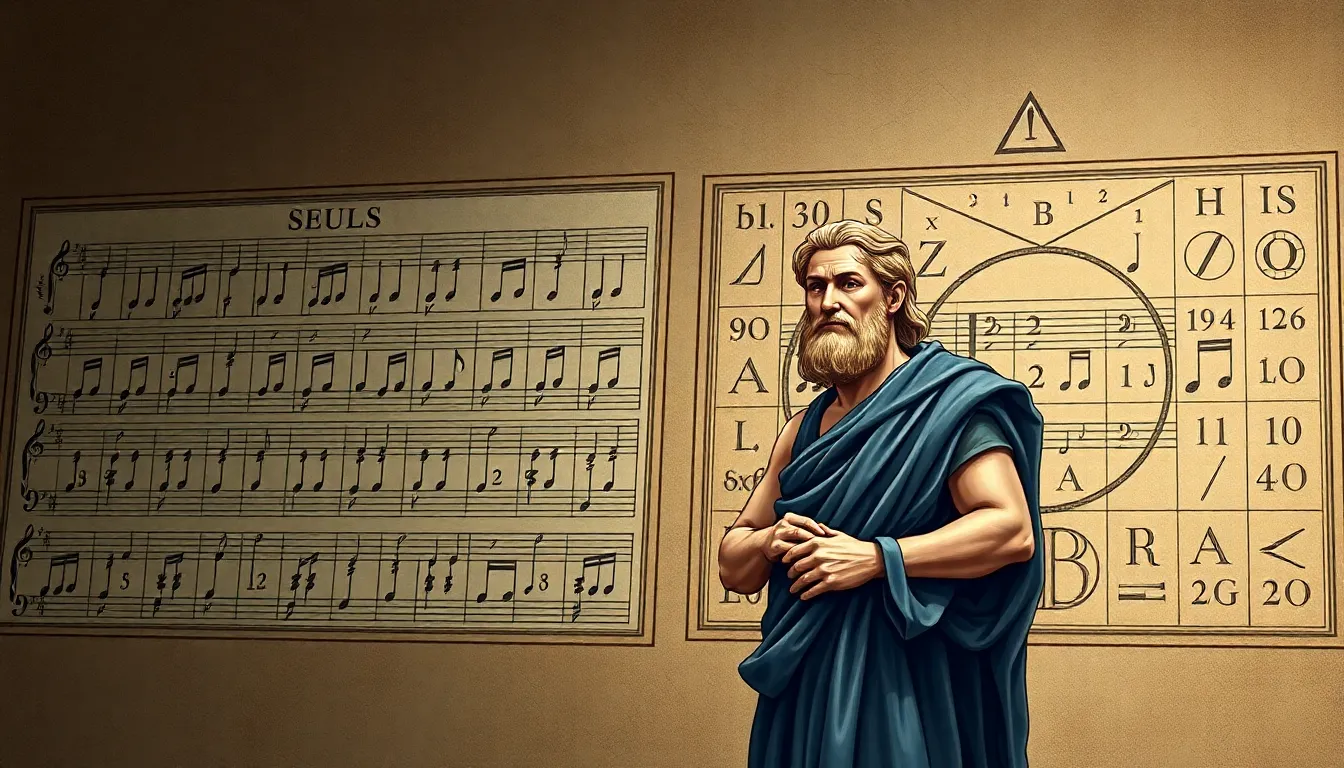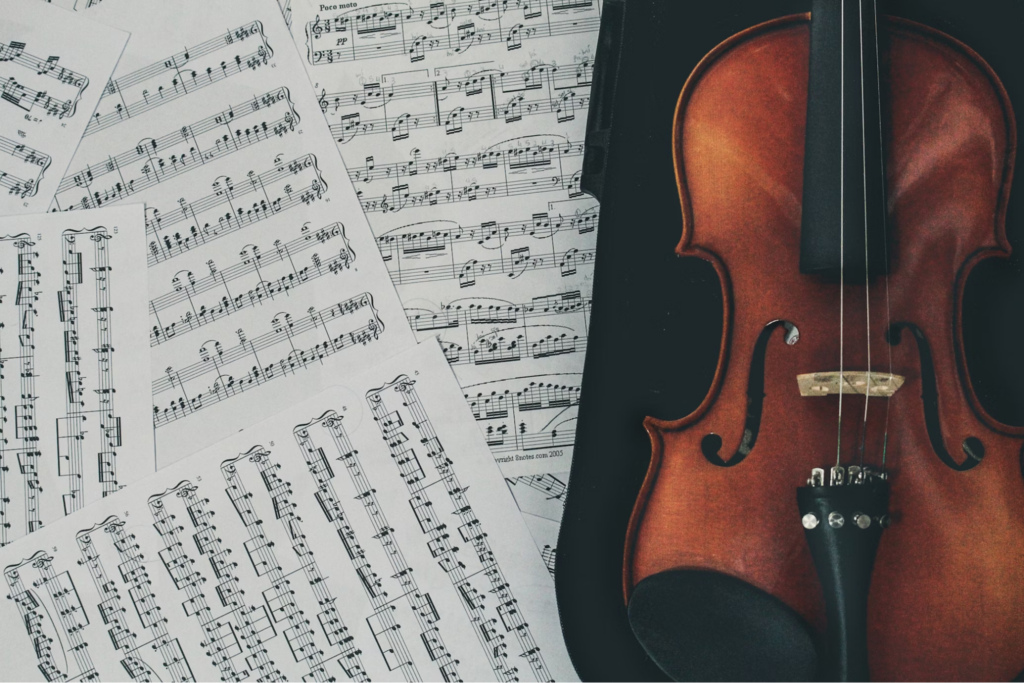Pythagoras isn’t just the guy who made triangles cool; he’s also the mastermind behind a fascinating connection between math and music. Imagine a world where numbers and melodies dance together in perfect harmony. That’s the magic of Pythagorean music theory. It’s like discovering that your favorite song has a secret recipe hidden in its notes, and trust us, it’s a tasty one.
Pythagoras Music Theory
Pythagoras music theory centers on the essential relationship between numbers and musical harmony. He discovered that specific numerical ratios correspond to musical intervals, such as the octave, fifth, and fourth. Understanding these ratios leads to a more profound appreciation of sound and its connections to mathematics.
The most notable ratio is the octave, which occurs at a frequency ratio of 2:1. Musicians achieve this by doubling a note’s frequency, resulting in a harmony that feels complete. Similarly, the perfect fifth has a frequency ratio of 3:2, creating a sound that complements the base note effectively. Exploring these ratios reveals why certain combinations sound pleasing to the ear.
Intervals also play a crucial role in creating scale systems. Pythagoras’ findings laid the groundwork for developing scales, which organize notes into a structure that musicians can use. For instance, the diatonic scale reflects the seven-note system prevalent in Western music, built from whole and half steps. Musicians and composers utilize this scale to craft melodies and harmonies that resonate with audiences.
Musical tuning systems derive from Pythagorean ratios as well. The tuning system known as Just Intonation employs these precise ratios to determine the relationship between notes. Musicians often prefer this system when aiming for pure harmonies. In contrast, the equal temperament tuning system divides an octave into equal parts, which allows for greater versatility in performance but sacrifices some harmonic purity.
Pythagoras music theory remains influential in contemporary music education. Understanding these mathematical principles helps musicians enhance their skills and improve their compositions. As technology evolves, musicians continue to explore and apply Pythagorean concepts, bridging the worlds of mathematics and music into a harmonious existence.
Historical Context

Pythagoras, a pivotal figure in mathematics and philosophy, significantly influenced the understanding of music theory. His exploration of numerical ratios laid the groundwork for correlating mathematics with musical harmony.
Pythagoras and His Influence
Influence extended beyond mathematics; Pythagoras’ ideas transformed how musicians approached sound. He discovered ratios like 2:1 for octaves and 3:2 for perfect fifths. These findings demonstrated how numbers create harmonious relationships in music. Concepts introduced by Pythagoras equipped musicians with tools to measure intervals and enhance compositions. His followers, often called the Pythagoreans, furthered these ideas, incorporating music into their philosophical teachings. This intersection of music and math not only shaped ancient music theory but also positioned Pythagoras as a pioneer in both fields.
The Birth of Mathematical Music
Mathematical music emerged as Pythagorean principles gained traction. Ratio relationships defined intervals and established the foundations of scales, leading to the development of the diatonic scale. Musicians utilized these scales, creating systems that organized notes systematically. The evolution continued as tuning systems like Just Intonation and equal temperament derived from Pythagorean ratios. These advances allowed for a structured approach to music composition and performance. Today, the impact remains evident as music theory continues to rely on mathematical concepts, showcasing the lasting legacy of Pythagorean thought.
Key Concepts in Pythagoras Music Theory
Pythagorean music theory hinges on numerical relationships, underpinning musical harmony. Understanding these concepts reveals the mathematical foundation of music.
The Role of Ratios
Ratios represent pivotal elements in Pythagorean music theory. The octave, characterized by a 2:1 ratio, signifies a fundamental connection between frequencies. A perfect fifth emerges through a 3:2 ratio, enhancing the harmonic structure. More broadly, these simple ratios create pleasing auditory experiences, guiding musicians in sound creation. For instance, the major third interval follows a 4:5 ratio, enriching musical texture. Such relationships help establish scales, facilitating composition across various genres. Pythagoras’s insight into these ratios laid the groundwork for systematic tuning approaches, enhancing musical performance and understanding. Various tuning systems, like Just Intonation, derive from Pythagorean concepts, emphasizing the integral union of mathematics and music.
Intervals and Harmony
Intervals occupy a central role in building musical harmony. Specific intervals, derived from Pythagorean ratios, determine the relations between notes. The frequency difference influences how music conveys emotion and mood. For example, a major third imparts a joyous feeling, whereas a minor third instills a sense of sadness. Pythagorean principles enable musicians to perceive and utilize these intervals in compositions. The harmonious combinations create resonance, resulting in satisfying soundscapes. Musicians rely on these intervals to construct melodies and harmonies that evoke emotional responses. Understanding intervals through the lens of Pythagorean theory fosters a deeper connection to musical expression. The exploration of these relationships shapes how music is created and experienced today.
Applications of Pythagorean Theory
Pythagorean theory finds significant applications in music. Musicians leverage numerical ratios to create harmonious compositions and explore emotional depth.
Music Composition
Music composition benefits greatly from Pythagorean principles. Composers often utilize intervals derived from mathematical ratios, crafting melodies that evoke specific emotions. Incorporating the perfect fifth (3:2) and major third (4:5), composers enhance musical phrases and structures. These ratios guide important decisions in harmony and melody, forming a foundation for various genres. Classical compositions notably exhibit these influences, as seen in works by composers like Bach and Mozart.
Modern Music Influence
Modern music continues to draw inspiration from Pythagorean theory. Many contemporary artists apply these foundational concepts, shaping genres such as jazz and pop. The equal temperament system, rooted in Pythagorean principles, allows for versatile tuning across instruments. This flexibility enables musicians to experiment creatively, blending styles and pushing artistic boundaries. Additionally, rhythmic patterns and harmonic progressions often reflect mathematical relationships, underscoring the theory’s enduring relevance.
Conclusion
Pythagoras’s exploration of the relationship between numbers and music continues to resonate in contemporary compositions. His insights into numerical ratios and their connection to musical intervals have shaped the way musicians understand harmony. The principles of Pythagorean music theory not only influence classical works but also inspire modern genres, allowing artists to evoke deep emotions through sound.
As musicians embrace these timeless concepts, they unlock new creative possibilities. The enduring legacy of Pythagorean theory serves as a reminder of the profound connection between mathematics and music, enriching the art of composition and performance. Through this understanding, the beauty of music remains intertwined with the elegance of numbers, creating a harmonious experience for listeners everywhere.



